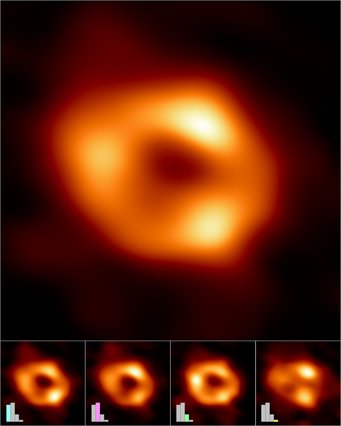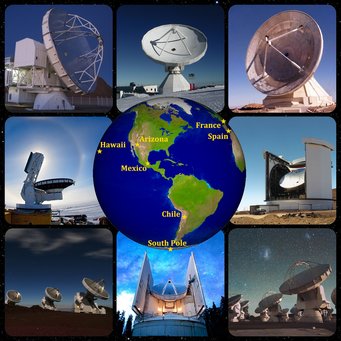Observation with the Event Horizon Telescope improves our understanding of the processes at the galactic centre
It sits deep in the heart of the Milky Way, is 27,000 light years from Earth, and resembles a doughnut. This is how the black hole at the centre of our galaxy appears in the image obtained by researchers using the Event Horizon Telescope (EHT). The team has thus provided evidence that, as suspected, this object belongs to the family of cosmic gravity traps. The radio data from the observatories connected in the worldwide EHT network were obtained from two supercomputers: one at the Max Planck Institute for Radio Astronomy in Bonn and one at the Haystack Observatory in Massachusetts. The Apex telescope of the Bonn Institute and the 30-metre antenna of the Institut de Radioastronomie Millimétrique (IRAM), which belongs to the Max Planck Society, were also involved in the observation.

Cosmic ring of fire: This is the first image of Sagittarius A*, the supermassive black hole at the centre of the Milky Way. It was taken by the Event Horizon Telescope (EHT), a network that combines radio observatories around the world into a single virtual telescope the size of the Earth. The EHT is named after the “event horizon”, the boundary of the black hole beyond which no light can escape. Although the event horizon itself is not visible because it does not emit light, glowing gas swirling around the black hole shows a tell-tale signature: a dark central region (shadow) surrounded by a bright ring-shaped structure. The image captures light bent by the strong gravity of the black hole and is four million times more massive than the sun. The image is an average of the various images extracted by the EHT collaboration from their observations in April 2017. The images can also be clustered into four groups based on similar features. An averaged, representative image for each of the four clusters is shown in the bottom row. Three of the clusters show a ring structure but, with differently distributed brightness around the ring. The fourth cluster contains images that also fit the data but do not appear ring-like. The bar graphs show the relative number of images belonging to each cluster. Thousands of images fell into each of the first three clusters, while the fourth and smallest cluster contains only hundreds of images. The heights of the bars indicate the relative contributions of each cluster to the averaged image at top.
© EHT collaboration
The recently published image is the long-awaited direct view of the object at the centre of our galaxy known as Sagittarius A*. For many years, researchers have been examining this area of the Milky Way and observing stars that orbit an invisible, compact, and massive object. For this work, Andrea Ghez from the University of California and Reinhard Genzel from the Max Planck Institute for Extraterrestrial Physics in Garching were awarded the Nobel Prize in 2020.
“Our discovery shows that the object at the galactic centre is indeed a black hole”, says Anton Zensus, Director at the Max Planck Institute for Radio Astronomy and founding chair of the Supervisory Board of the EHT. The image is the first direct visual proof of this. The black hole itself is not visible in the image because it does not emit any radiation. But the glowing gas around it shows a tell-tale signature – a dark central region (shadow) surrounded by a bright ring-like structure. Their light is bent by the immense gravity of the black hole.
“We were amazed at how well the size of the observed ring matched the predictions of Einstein’s general theory of relativity”, says EHT project scientist Geoffrey Bower from the Institute of Astronomy and Astrophysics at Academia Sinica in Taipei. The observations would greatly have improved the understanding of the physical processes taking place at the centres of galaxies and would provide insights into how such giant gravity traps interact with their surroundings.
Because the black hole at the centre of the Milky Way is 27,000 light years away from Earth, it appears to us in the sky about as big as a doughnut on the moon. In order to image it, the team created the powerful EHT, which links eight (now 11) radio observatories around the world into a single Earth-sized virtual telescope. Using interferometry, the astronomers observed the object Sagittarius A* during several nights in April 2017. At a wavelength of 1.3 millimetres, they collected data for many hours at a time – similar to the long exposure time of a camera. These data were analysed by two correlators – high-performance computers located at the Max Planck Institute for Radio Astronomy and the Haystack Observatory.
The Max Planck Institute was also involved in the campaign with an antenna. “The contribution of our Apex telescope was essential for perfectly calibrating the changing brightness of the source and providing definitive proof of the black hole shadow at the galactic centre”, says Director Karl Menten.

Worldwide network: When the researchers collected the data from the centre of the Milky Way in 2017, the Event Horizon Telescope consisted of eight observatories spread across the globe.
© EHT collaboration
The current observation follows the 2019 image of a black hole (M 87*) at the centre of the galaxy Messier 87, which lies at a much greater distance from Earth. The two black holes are similar – although the one at the centre of the Milky Way is more than one thousand times smaller and much lighter than M 87*. “We are dealing with two completely different types of galaxies and two different masses of black holes. But near their edges, they look amazingly similar”, says Sera Markoff, co-chair of the Council of Sciences of the EHT and professor of theoretical astrophysics at the University of Amsterdam.
This time, the evaluation of the data was much more difficult than with the galaxy M 87, 55 million light years away – even though the centre of the Milky Way is much closer (27,000 light years). The gas swirls around the two black holes at practically the same speed – almost as fast as light. But while it takes days to weeks to orbit the larger object M 87*, it orbits of the much smaller Sagittarius A* in just a few minutes. “The brightness and appearance of the gas around Sagittarius A* thus changed rapidly during our observation”, says Chi-kwan Chan from the University of Arizona. “It’s like trying to take a sharp image of a dog vigorously wagging its tail”.
The researchers had to develop sophisticated new methods in order to explain the gas movements around the Sagittarius A* black hole, which “weighs” around four million solar masses. In contrast, M 87*, weighing six and a half billion solar masses, was an easier and more stable target. In addition, Earth is in the galactic plane; this causes a scattering effect in the radio measurements. Hot gas with charged particles and magnetic fields in the line of sight also complicate the analysis.
The image of Sagittarius A* is thus an average of various images that the team extracted from the data. Maciek Wielgus and Michael Janßen, both from the Max Planck Institute for Radio Astronomy, played a major role in the calibration. For tests of general relativity and proof of an event horizon, their colleague Gunther Witzel compiled the results of other observations.

Concentrated computing power: The scientists used this high-performance computer at the Max Planck Institute for Radio Astronomy to analyse the data from the Event Horizon Telescope. A second correlator is located at the Haystack Observatory in the US.
© MPIfR
The EHT collaboration includes more than 300 researchers from 80 institutes worldwide. Over the past five years, the team has developed complex instruments and compiled a unique library of numerically simulated black holes to compare with observations. Among other things, these serve to test the theories of gravitation.
According to Michael Kramer, Director at the Max Planck Institute and one of the project leaders of the Black Hole Cam project, the earlier image of M 87* was only partially suitable for this purpose. “For Messier 87, we had no reliable prior knowledge about the mass of the black hole. In the current case, it is quite different. Thanks to previous measurements such as those by Reinhard Genzel, we know both the distance and the mass of Sagittarius A* quite precisely. We were thus able to calculate the expected shadow size in order to compare it with the observations. And it fits quite well.” The Black Hole Cam project was funded by the European Research Council (ERC) and plays an important role within the EHT collaboration.
Using the images of the two differently-sized black holes, the researchers can compare the two objects and check how they differ. The new data can also be used to test theories and models about how gravity and matter behave in the extreme environment of supermassive black holes. This is not yet fully understood but apparently plays a key role in the formation and evolution of galaxies.
IRAM Director Karl Schuster emphasizes the many years of joint pioneering work between the Max Planck Institute for Radio Astronomy and his institute in Grenoble, France. “The results from the Event Horizon Telescope are an ideal complement to the results obtained by Reinhard Genzel’s group at the Max Planck Institute for Extraterrestrial Physics in the infra-red range with the Gravity instrument”. Meanwhile, measurements with the Event Horizon Telescope continue. Eleven observatories were involved in a major campaign in March 2022. “Of course, we are all quite excited to see what the EHT observations in 2021 and 2022 will reveal with the participation of our powerful Noema observatory”, says Schuster.
ER / HOR / NJ








